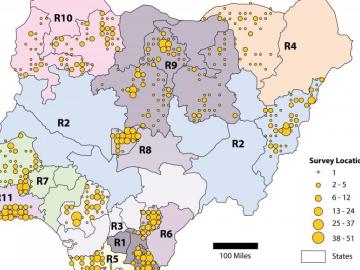
Filter News
Area of Research
- (-) Data (1)
- (-) Fusion and Fission (54)
- (-) Fusion Energy (17)
- (-) National Security (79)
- Advanced Manufacturing (34)
- Biological Systems (18)
- Biology and Environment (177)
- Biology and Soft Matter (5)
- Building Technologies (12)
- Chemical and Engineering Materials (4)
- Chemistry and Physics at Interfaces (11)
- Clean Energy (522)
- Climate and Environmental Systems (14)
- Computational Biology (6)
- Computational Chemistry (5)
- Computational Engineering (5)
- Computer Science (19)
- Earth Sciences (1)
- Electricity and Smart Grid (3)
- Energy Frontier Research Centers (14)
- Energy Sciences (5)
- Fossil Energy (3)
- Fuel Cycle Science and Technology (3)
- Functional Materials for Energy (16)
- Geographic Information Science and Technology (3)
- Isotope Development and Production (3)
- Isotopes (35)
- Materials (433)
- Materials Characterization (2)
- Materials for Computing (36)
- Materials Synthesis from Atoms to Systems (13)
- Materials Under Extremes (12)
- Mathematics (1)
- Neutron Data Analysis and Visualization (4)
- Neutron Science (190)
- Nuclear Science and Technology (74)
- Nuclear Systems Modeling, Simulation and Validation (3)
- Nuclear Systems Technology (1)
- Quantum Condensed Matter (4)
- Quantum information Science (9)
- Reactor Technology (1)
- Renewable Energy (4)
- Sensors and Controls (5)
- Supercomputing (311)
- Transportation Systems (11)
News Topics
- 3-D Printing/Advanced Manufacturing (6)
- Advanced Reactors (14)
- Artificial Intelligence (13)
- Big Data (6)
- Bioenergy (4)
- Biology (6)
- Biomedical (3)
- Biotechnology (1)
- Buildings (2)
- Chemical Sciences (6)
- Climate Change (5)
- Composites (1)
- Computer Science (23)
- Coronavirus (2)
- Critical Materials (1)
- Cybersecurity (19)
- Decarbonization (4)
- Energy Storage (6)
- Environment (7)
- Exascale Computing (2)
- Fossil Energy (1)
- Frontier (3)
- Fusion (35)
- Grid (8)
- High-Performance Computing (6)
- Isotopes (1)
- ITER (6)
- Machine Learning (12)
- Materials (4)
- Materials Science (9)
- Microscopy (1)
- Nanotechnology (2)
- National Security (34)
- Net Zero (1)
- Neutron Science (5)
- Nuclear Energy (40)
- Partnerships (7)
- Physics (2)
- Quantum Science (1)
- Security (13)
- Simulation (4)
- Space Exploration (1)
- Summit (3)
- Sustainable Energy (9)
- Transportation (4)
Media Contacts

As program manager for the Department of Energy’s Oak Ridge National Laboratory’s Package Testing Program, Oscar Martinez enjoys finding and fixing technical issues.

The INFUSE fusion program announced a second round of 2020 public-private partnership awards to accelerate fusion energy development.

Jeff Johnson, nonproliferation research and development integration manager for ORNL’s National Security Sciences Directorate, has been honored by the American Nuclear Society

Six ORNL scientists have been elected as fellows to the American Association for the Advancement of Science, or AAAS.

David Kropaczek, director of the Consortium for Advanced Simulation of Light Water Reactors, or CASL, at the Department of Energy’s Oak Ridge National Laboratory, has been named a fellow of the American Nuclear Society.

Chuck Kessel was still in high school when he saw a scientist hold up a tiny vial of water and say, “This could fuel a house for a whole year.”

The Transformational Challenge Reactor, or TCR, a microreactor built using 3D printing and other new advanced technologies, could be operational by 2024.

Department of Energy Under Secretary for Science Paul Dabbar joined Oak Ridge National Laboratory leaders for a ribbon-cutting ceremony to mark progress toward a next-generation fusion materials project.

Oak Ridge National Laboratory scientists helped count the population of Nigeria – all without leaving the lab.

A developing method to gauge the occurrence of a nuclear reactor anomaly has the potential to save millions of dollars.


